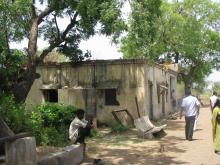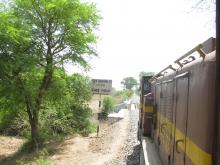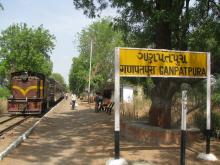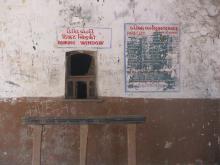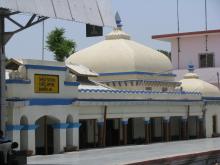The Bombay Baroda and Central India Railway (BB&CI), one of the first guaranteed railway companies in India, opened the Ankleshwar- Bharuch broad gauge line on 22nd June, 1860. Earlier in 1855, sensing the prosperity railways could bring to the state, the Maharaja of Vadodara state (then called Baroda) Ganpatrao had given permission to BB&CI for constructing railway lines in his state. Bharuch-Baroda broad gauge line was inaugurated on 9th January, 1861. By this time, Khanderao had become the new Maharaja.
Dabhoi in Baroda state was an important trading center. In early 1850s Khanderao, had built a line between Miyagam Karjan and Dabhoi. It was on two feet six-inch gauge with rails weighing 13 lbs to a yard. The line was designed and constructed by A.W.Forde. A pair of oxen used to haul trains composed of 4-6 vehicles. Why did Khanderao choose narrow gauge over the then popular broad gauge? This question remains unanswered. He was probably persuaded by sales personnel from Neilson locomotive company to buy narrow gauge locomotives for the line and hence choose the narrow gauge. In 1863, Khanderao purchased 3 steam locomotives built by Neilson and Co., Glasgow. These 0-4-0 tank locomotives proved to be too heavy for the rails and were soon removed from duty. The line was not managed properly in the early years and ended up being a financial drain on the state exchequer. As a result, services were closed and over time some of the rails and bridges woodwork were stolen.
During the reign of Malharrao in 1871, fresh proposals were submitted by consulting engineer for BB&CI to restore the line. Upon approval from the state, the old rails were removed and new rails 30 lbs to a yard were laid. The work was executed by the firm M/s Rustomjee Nowrojee of Bombay. Three stations were built; old bridges and culverts were repaired. The Miyagam-Dabhoi line was reopened for traffic on 8th April, 1873. The three locomotives purchased earlier along with new rolling stock designed by E.B. Carroll were pressed into service. The management of line was handed over to BB&CI Company. Dabhoi was now connected with BB&CI mainline from Bombay at Miyagam.
For the history buffs the world’s oldest NG line was built in 1869. It was on two-foot gauge and connected Portmadoc in North Wales with Festiniog and its slate quarries. In the 70's this line was closed down before being restored again for tourism in early 90's. So Dabhoi-Miyagam line holds two world records-The oldest two and half feet gauge railway in the world and the oldest continuously working narrow gauge line (narrow gauge includes two feet and two and half feet gauge).
For a long time, steam locomotives reigned supreme. After 0-4-0 tank locomotives, 0-4-2 tender locomotives were introduced in 1891, followed by 0-6-2 Kittson manufactured locomotives in 1902 and finally in 1912, Bagnall manufactured 0-6-2 locomotives. In 1928, 2-6-2 ZB class locomotives, manufactured by Bagnall were introduced. In 1990 diesel traction was introduced on Western railway and soon the steam locomotives were to be replaced by diesel locomotives. Nowadays ZDM5 diesel locomotives, manufactured by Chittranjan locomotive works haul the trains. A small diesel shed has been recently constructed at Dabhoi. Major repairs and overhaul are carried out at Pratapnagar workshop near Vadodara.
The 32.3 km long journey starts from Miyagam Karjan which is on Bombay- Vadodara broad gauge line. There are four daily services. From Dabhoi the first service, 028 starts at 0955 hrs and the last, 020 at 1920 hours. From Miyagam, the first service 019 starts at 0615 hrs and the last 027 at 1400 hours. Each train has five-seven second class coaches, manufactured mostly at Southern Railway workshop of Mysore. Tickets at intermediate stations are sold by the guard on the train.
The first station after Miyagam is Kandari, five kilometers away. Since the track is not in good condition speed limit on this section is a mere 20kms/hour. This is only a two-board station which proudly proclaims the name of the station. There is neither station building nor any other amenity for the passengers. Three kilometers later the next station Ganpatpura, tells a similar tale. The track now is in such a bad condition that it takes twenty minutes to cover this distance of three kilometers. New rails have been laid after this station and the wooden sleeper have been replaced with irons one. As result speed limit has been increased to 35kms/hour. Six kilometers from Ganpatpura is the Kayavorohan station. This station is close to famous Lakulishji temple visited by hundreds of devotees every year. This is the only station on the route that has a station building with station master on duty and a booking office. Since this station also has sidings, trains coming from either direction cross at this station. After this there are three more stations till Dabhoi- Parikha, Baripur Mandala and Nada. The track after Mandala station is still to be replaced and as a result the old speed restriction of 20kms/hour again applies. The train finally reaches Dabhoi after having covered the 32 km distance in two hours! Along way, the train would have gone over 41 minor bridges, crossed 19 manned level crossings and negotiated 7 curves.
With gauge conversion in full swing and most narrow-gauge lines around Dabhoi being converted to broad gauge, the days for this piece of rail history is clearly numbered.

